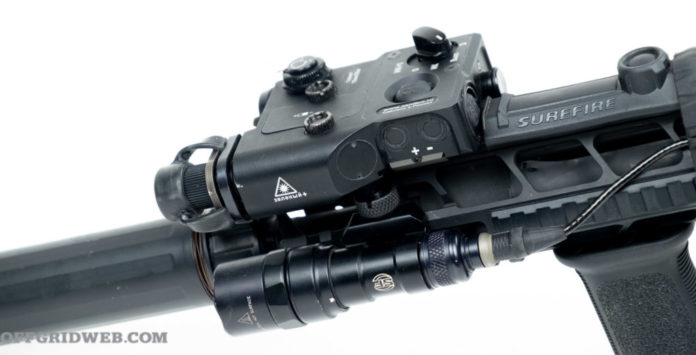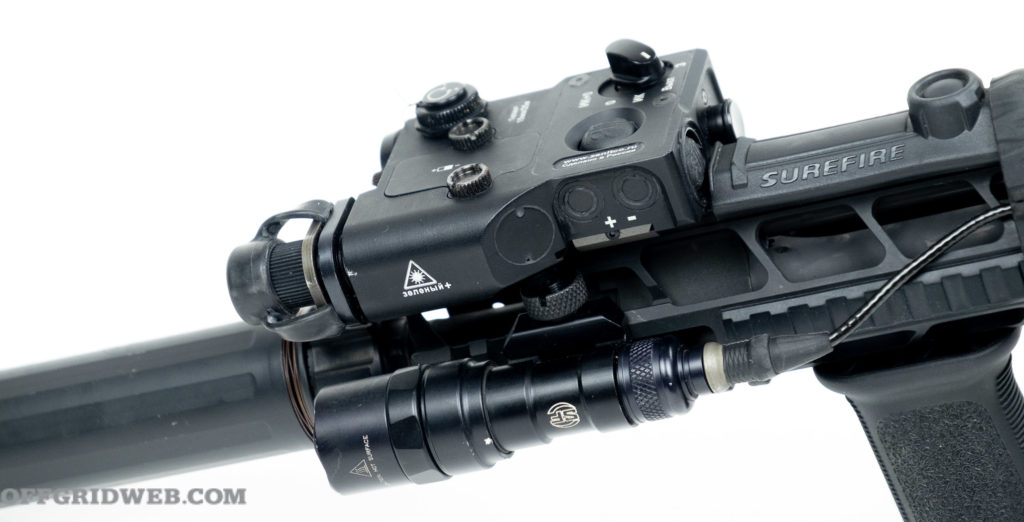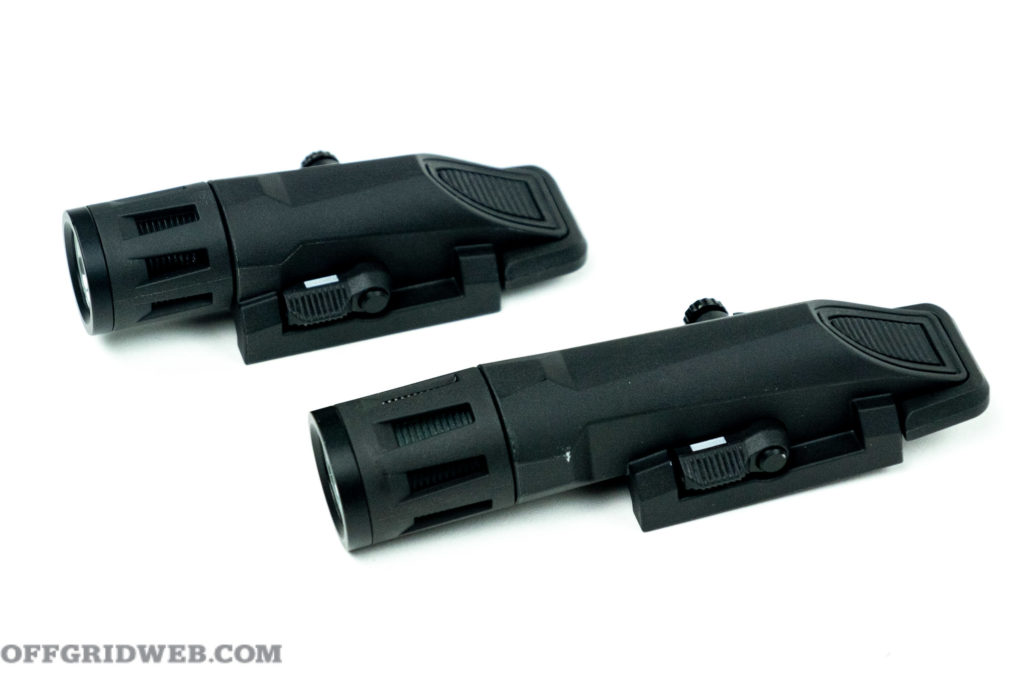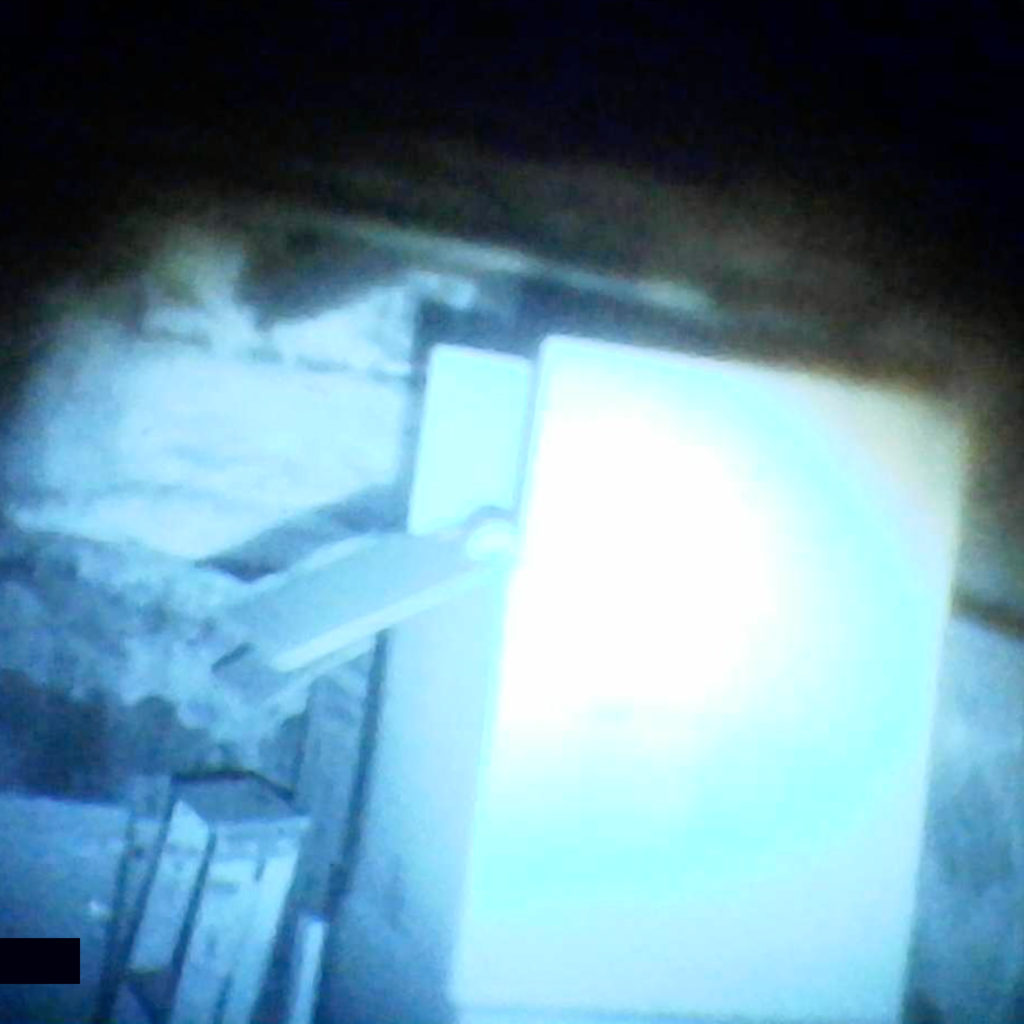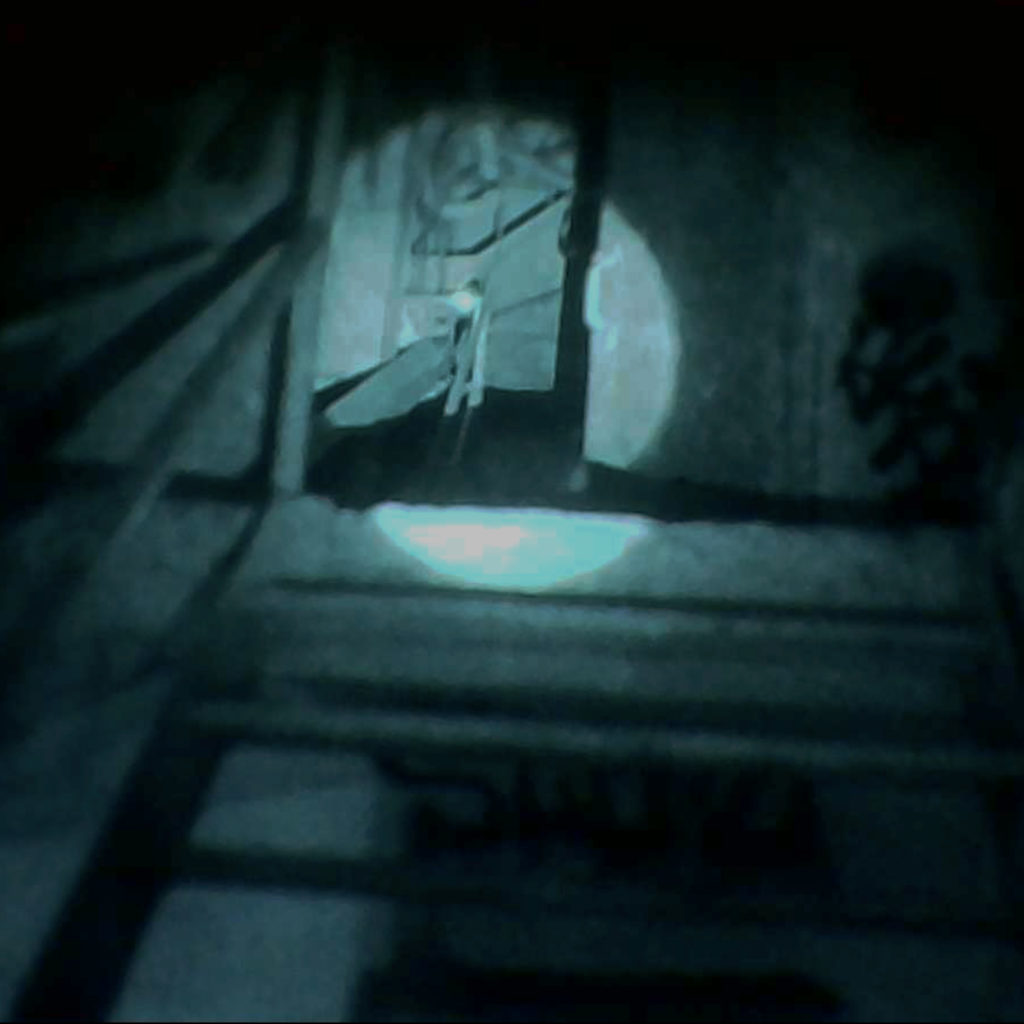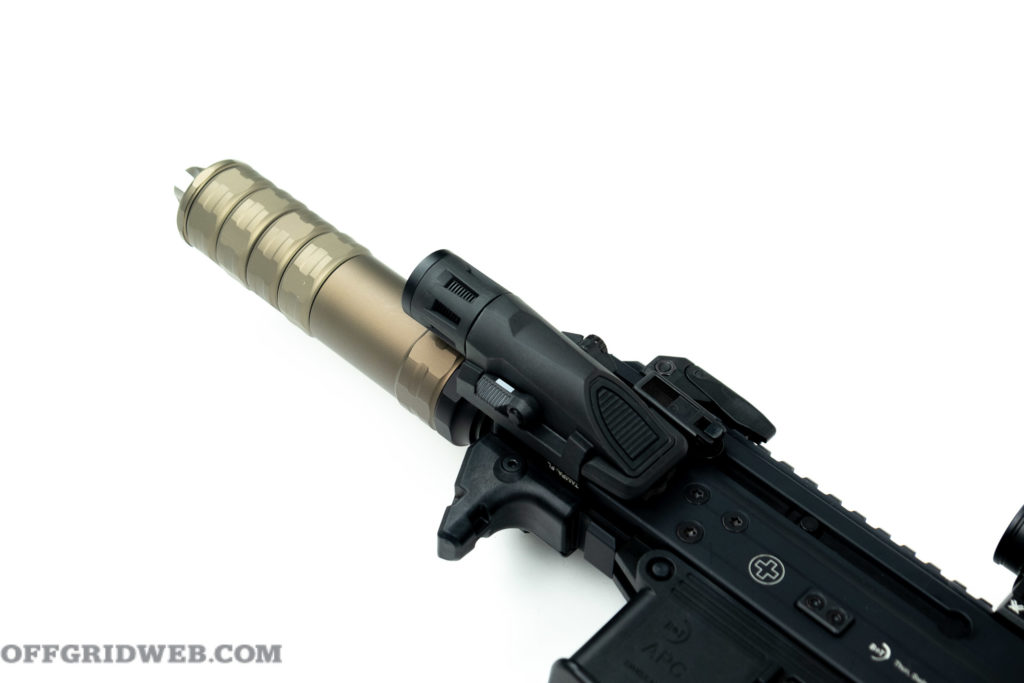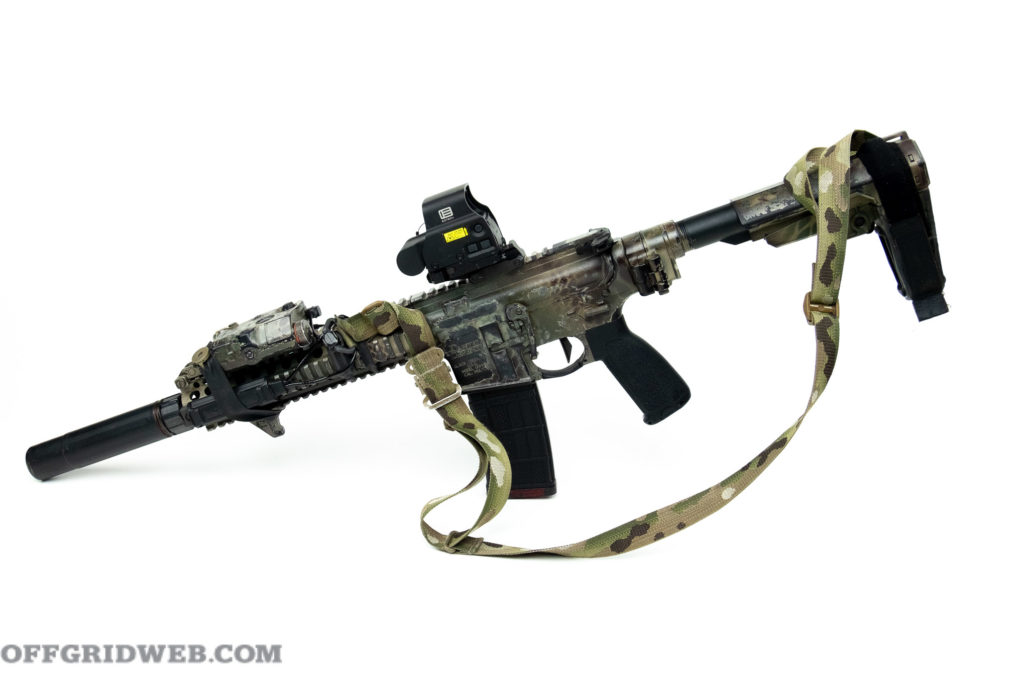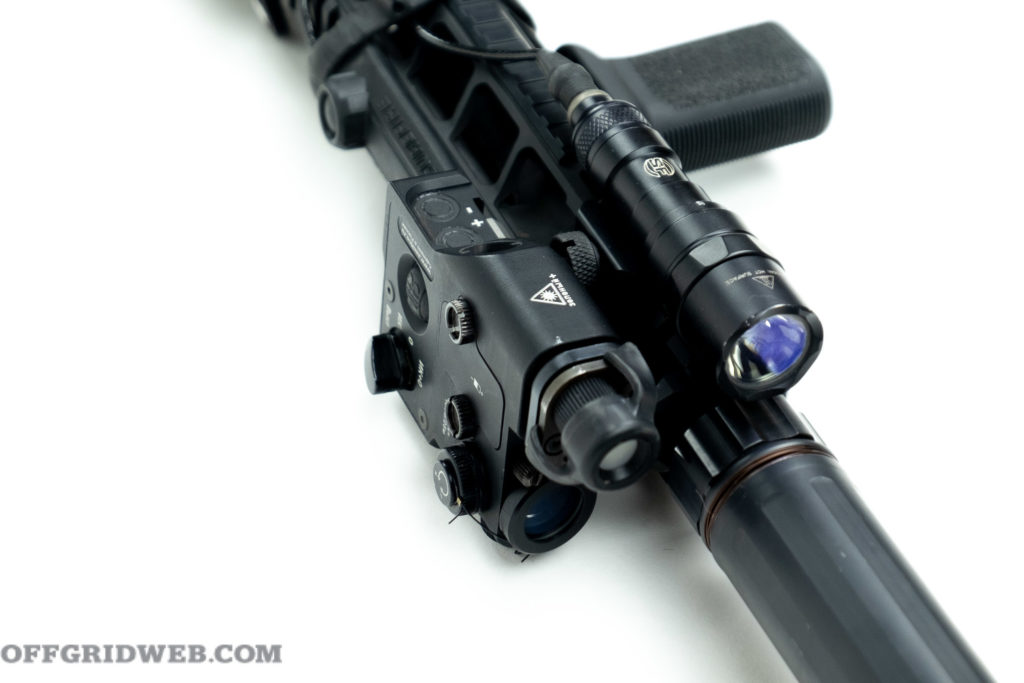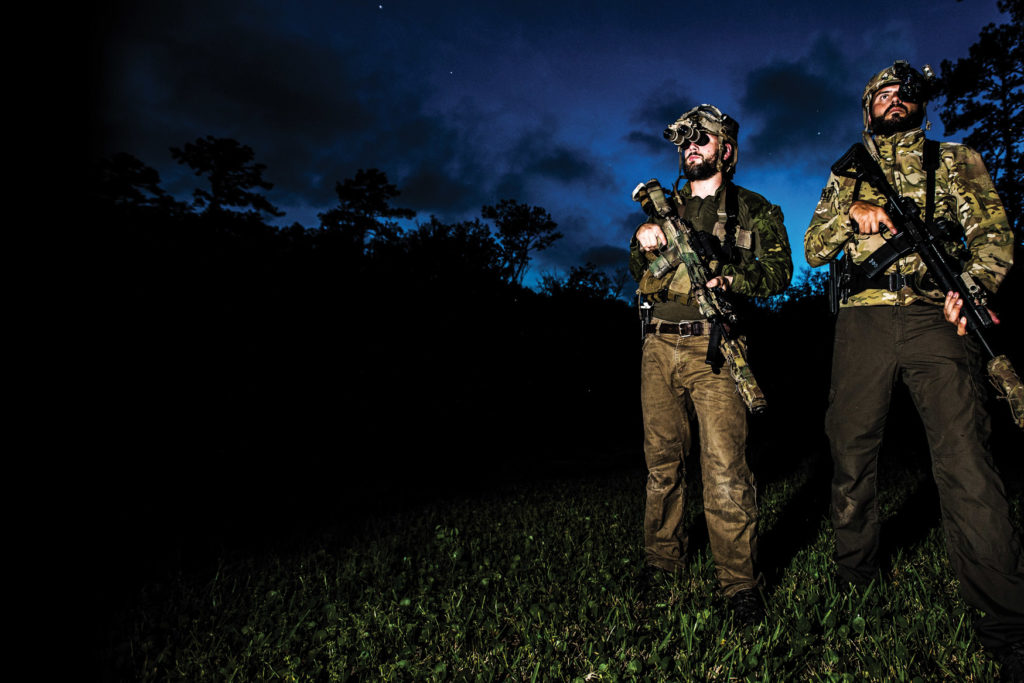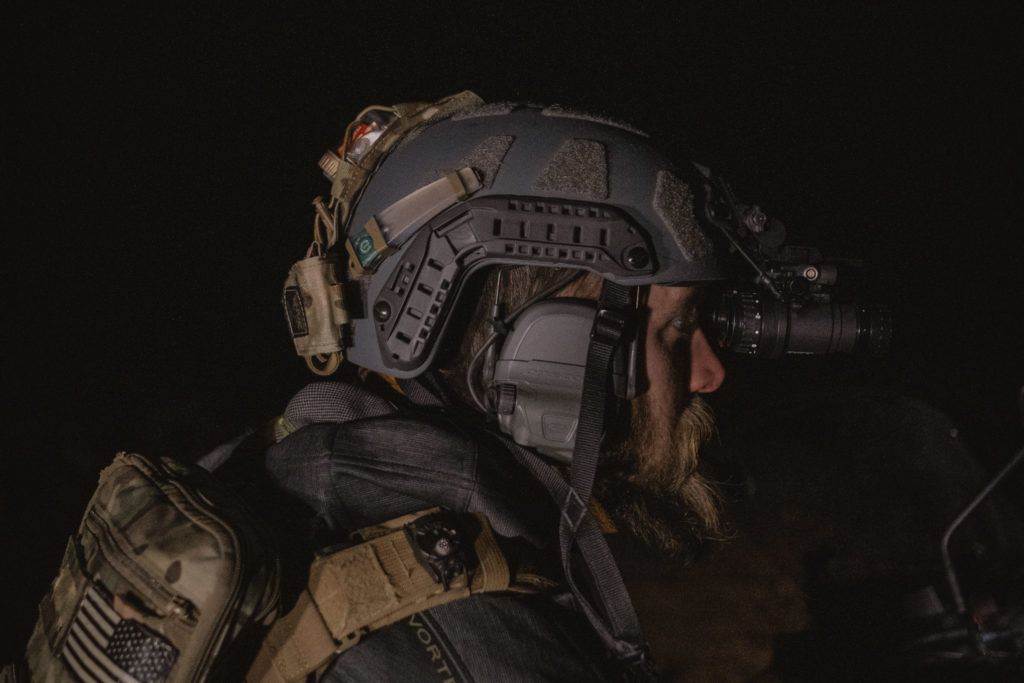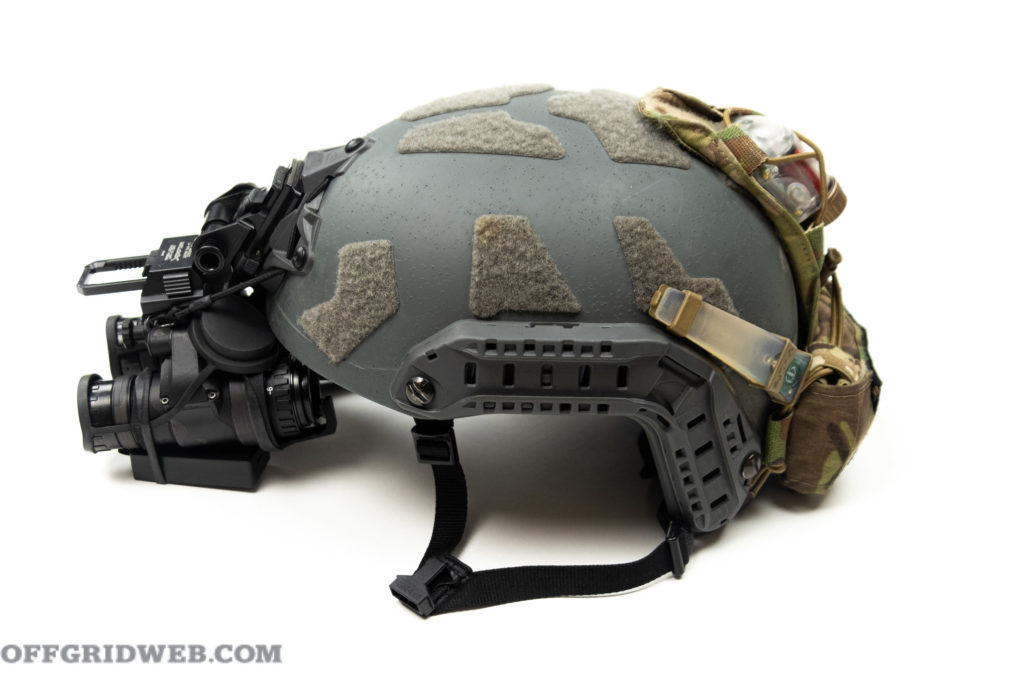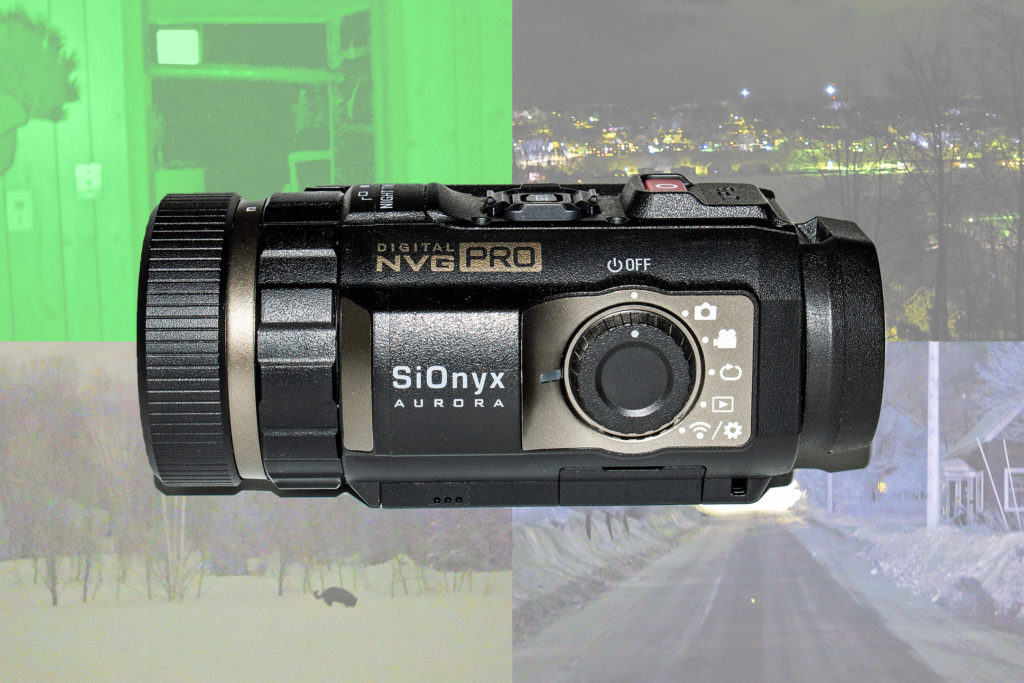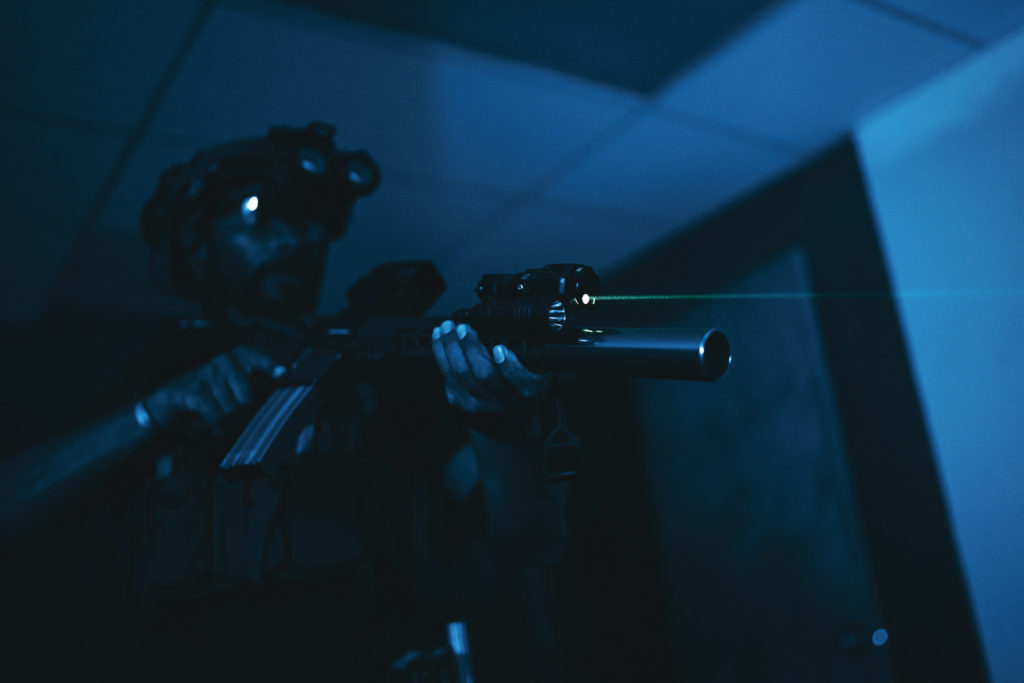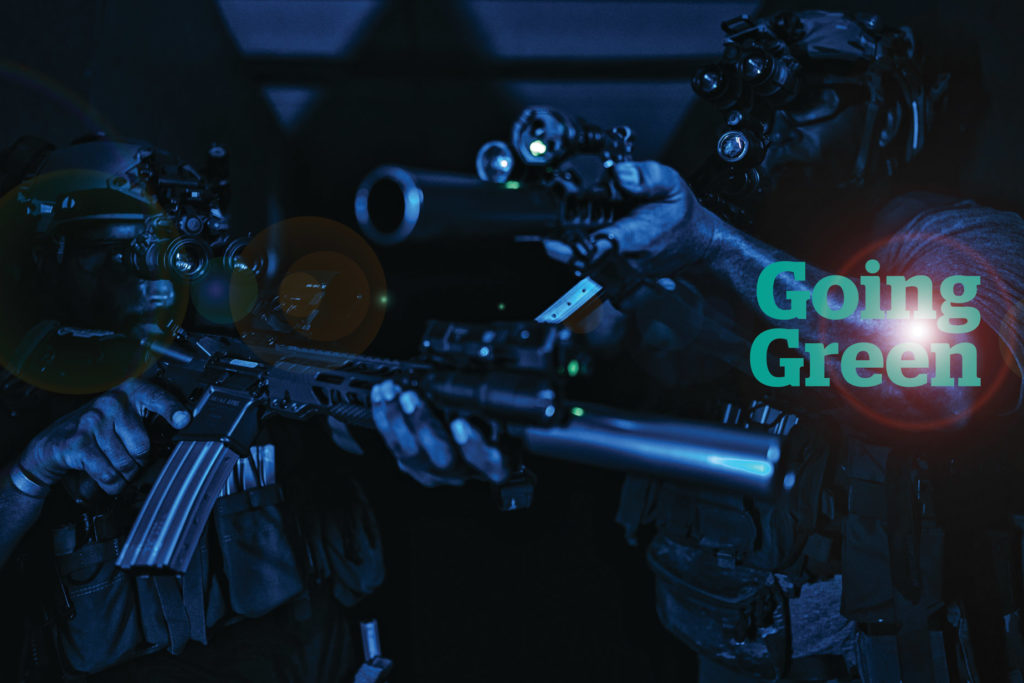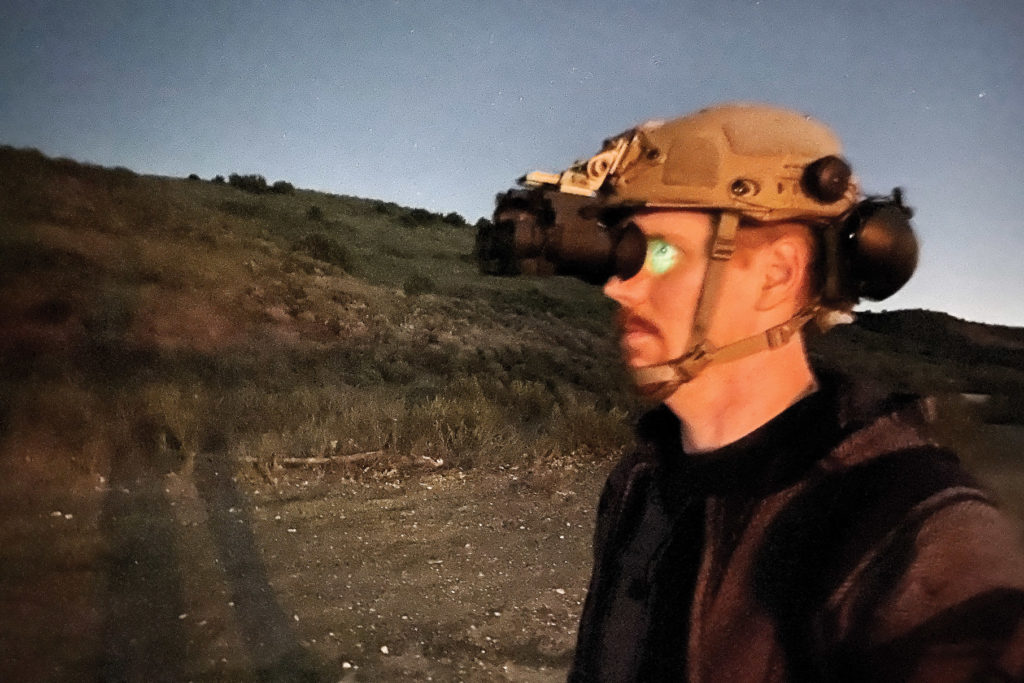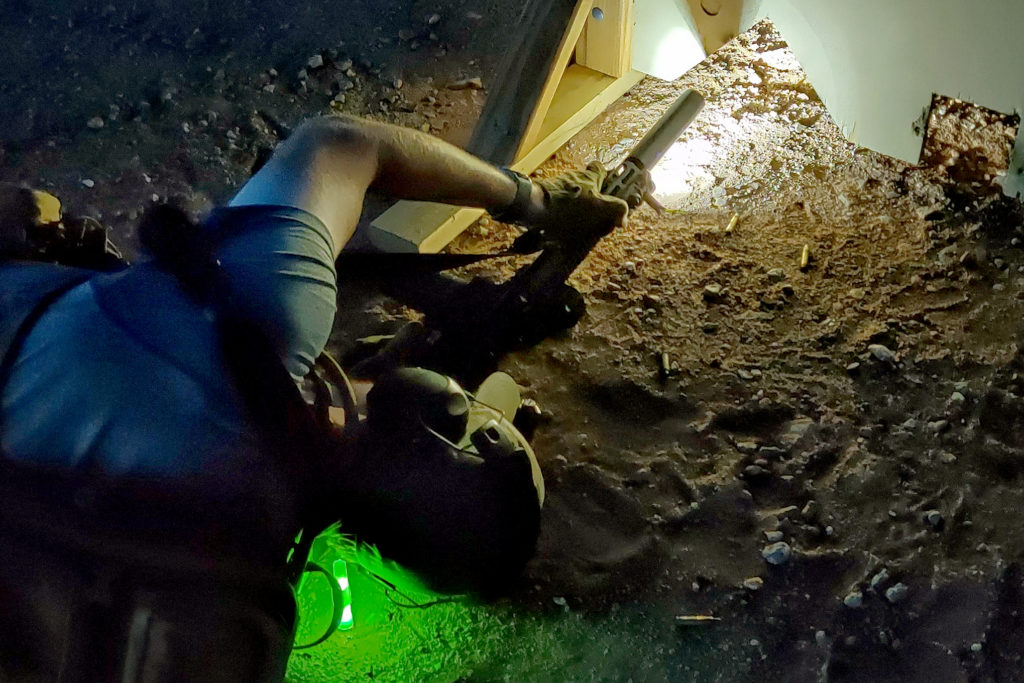There is a great difference between having access to night vision goggles and being truly night capable. When talking about armed preparedness, the next issue after getting night vision, is having one or more ways to aim your weapon when using them. Taller mounts for red dot sights and holographic optics, as well as infrared (IR) lasers, meet these requirements. But being fully setup for night-fighting doesn’t even stop there. A deeper familiarization with night vision technology reveals the limits of its capability: it doesn’t work in absolute darkness, and even under NVGs, there still are shadows to hide in. More than just an advantage, an IR Illuminator is necessary for those who seek to take maximum advantage of the darkness, so much so that those without it face a serious, if not final disadvantage.
What is an IR Illuminator?
In the most basic description, an IR illuminator is a flashlight that only uses light within the IR spectrum. Invisible to the naked eye, it can be seen only by optical tools that pick up the infrared side of the spectrum, such as security cameras and night vision goggles. They typically come in two forms: integrated into an IR laser/illuminator device such as an ATPIAL-C or in a stand-alone format, much like a weapon mounted light.
Integrated
Military-style laser/illuminators dominate this market, by far, with representatives starting to pop up from Russia and beyond. These devices typically have the option to select what type and intensity of light is being emitted. The foundation of a laser/illuminator will focus on IR wavelength transmission, but some include features such as visible lasers, white (visible) light integration, and the option to use a pressure switch/tape switch for activation. Most laser/illuminators are designed for use on larger frame guns, such as AR-15’s, but some handgun models are starting to become more common.
A key feature that an integrated IR illuminator will include, is the ability to “slave” the flood illumination to the laser: when one is on, so is the other. With one press of the activation switch, both the IR illuminator and laser turn on, providing both a point of aim, and a cone of illumination around it. Propper functioning models will allow the user to both adjust the aiming laser, and the IR illuminator. Some include the ability to adjust the throw of the illuminator as well, for focusing or diffusing the circle.
Stand-Alone
In some cases, IR-capable laser devices are not equipped with an integrated IR Illuminator, or they could be damaged. Whether as a backup or as supplemental, some modern flashlights and weapon-mounted lights have the ability to be switched from white-light to IR by either rotating the bezel or engaging a toggle. While in most cases this is viewed as an alternative less desirable than an integrated option, there are examples (such as searching a woodline) that challenge the supremacy of integrated units.
Generally speaking, stand-alone IR illuminators have a wider, softer throw of light: the center of the beam is not as hot, and tends to be much wider with a softer edge. The advantage of this beam pattern comes to life in heavily vegetated environments, as the wider illumination provides more visible context in a shorter amount of time. In addition, it is less likely to reflect as intensely towards the user.
Above: A Stand-Alone IR illuminator typically throws a pattern similar to a flashlight: less concentrated. Below: the IR Flood pattern on a PEQ-15/Atpial-C is much smaller, and more focused, but evenly distributes the “light” without hotspots.
Apart from the downside of having two buttons to press instead of a single laser/illuminator slaved combo, the crisp circle that an integrated unit typically projects helps in team activities, drawing attention to a specific object, person, or area. The more focused beam of an integrated unit is better for searching people at distance, especially as they produce an even amount of illumination across a target, rarely with hotspots, showing contours and helping to identify concealed weapons. With the more focused illumination, it reflects less on the foreground, providing the benefit of target discrimination, with the downside of further encouraging tunnel vision in addition to already looking through night vision goggles.
Getting Set Up
When setting up a firearm for use with NODs, one must be able to at least activate the laser and illuminator at the same time. This can be accomplished by either using an integrated unit such as a PEQ-15, BE Meyers MAWL, Perst-4, ATPIAL-C, L3 NGAL, or similar devices, or by attaching the illuminator in such a way that both can be activated simultaneously. For example, on an AR-15, two pressure switches placed next to each other can be pressed at the same time. Another option is to place an IR capable light, such as an INFORCE WML WHITE/IR, with its slanted tail switch directly in front of a remote pressure switch for a laser of some type. Finally, opposing activating buttons, on the 3- and 9-o’clock sections of a rail allow the user to “pinch” the whole rail for dual activation. There are also niche dedicated solutions like the TAPS or Hot Button from Unity Tactical.
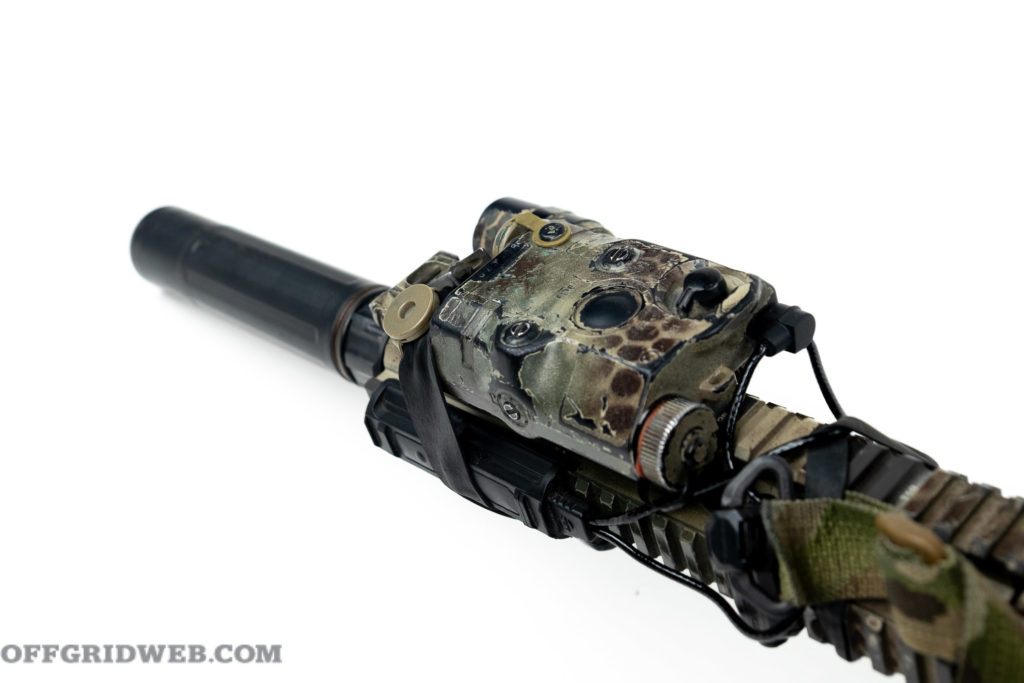
Regardless of equipment and setup, significant practice adjusting and activating both must take place. In addition, the user must be able to replace the batteries of all equipment in the dark, as disaster waits for no man.
How to Use: More than Just a Flashlight Invisible to Most
The first rule of any night operations is light discipline: as much as the darkness can be used as an advantage, accidentally turning on your white light will beacon your location to anyone looking in that direction. In hostile environments, this can give away your position faster than carrying a torch. As more and more people, foreign and domestic, are acquiring night vision technology, this applies more and more to the IR spectrum as well.
Easily overlooked at first, the illuminator ranks as one of the most vital components of night activities. Capable of searching and area or designating to allies, as well as dissipating the shadows that remain in even a very-dimly-lit environment.
For example, when looking at a building from the outside, when all the internal lights have been turned off, even under night vision, darkness envelopes the interior rooms. An illuminator, if shined in through a window, even at a distance, allows the user to see into the building. In this case, an IR illuminator accomplishes what solo night vision cannot: truly seeing in otherwise absolute darkness.
Depending on cloud cover, the phase of the moon, and the presence or lack of light pollution from nearby man-made structures, it is possible for an outdoor area to become so dark at night that it limits the usefulness of night vision on its own. Even on nights where the natural lume (ambient light) allows the wearer to see things such as buildings and treelines, they will be unable to see into them without the help of an illuminator. Since the primary advantage of night vision is to use darkness to one’s advantage, without an IR illuminator the results are severely limited.
Just as with a laser, activating an IR illuminator must be restricted to when needed, and limited in use so as to avoid giving away one’s position. When observed with a night vision camera, a laser will draw a straight line to the one holding it. In similar fashion, an IR illuminator works like a flashlight, which allows enemies to locate you as easily as allows you to locate them.
Combined with the limited field of vision that NVGs allow, this ability to make quick observations of one’s environment, and mentally mapping them subconsciously to avoid obstacles like holes in the ground or low furniture is the hallmark of a skilled user. Further, while moving and continually scanning through their night vision, and limiting their use of their laser/illumanator except for when identifying threats, known and suspected, the wearer is more likely to maintain the element of surprise, especially in near-peer scenarios, such as force-on-force training.
Above: The proliferation of taller optics risers can largely be credited to the concern of near-peer threats: hostile forces who are also night vision capable. The taller mount makes it easier to use one’s Red Dot or Holographic as a method of aiming, even under NVG’s.
The ability to set the brightness of an IR illuminator, if your unit has that feature, comes into play when changing environments. For example, when entering and exiting a building. The confined environment reflects the illuminator’s beam such that it could quickly blind out the wearer. Most modern laser/illuminator combinations have this option, but it is up to the user to be skilled in turning it down before entering a building. When in doubt, stay dimmer. Most stand-alone options do not have this option, but instead cast a more diffused beam to avoid blinding out the user’s night vision devices as much as possible.
Less natural light = Lower intensity setting on your IR Illumination.
IR Iluminator: Conclusion
Even if equipped with night vision goggles, and a laser aiming device, excluding an IR illuminator creates a significant disadvantage. It’s it best not to think of an IR illuminator as one more piece of kit to improve one’s capabilities, but vital to the system as a whole. Without it, you can find yourself in places too dark even for night vision, or gain no advantage over anything that creeps in the shadows.
Those in the military are faced with different decisions than civilians who own night vision. Bound by various limitations such as cost and timing, a private citizen may have to take becoming night capable one step at a time, starting with NVGs, and not being able to acquire a light/laser combination, opt for a systematic acquisition over time. A Perst-4 laser, which has no illuminator, can be purchased for around $550-600, leaving plenty of room for an IR-capable weapon mounted light, all for nearly half the price of most integrated models.
Weighing the pros and cons of each approach, an integrated system will most often be the better option. When making a serious commitment to building true-night-capability into your preparedness plan, the cost of entry is high but the payoff is worth it. Whether for hunting, night exploration, or recreation, consider an IR illuminator mission-essential equipment.
Some IR Illuminators to Look At:
– INTEGRATED –
L3Harris ATPIAL-C
Dimensions: 4.6″(L) x 2.8″(W) x 1.6″(H)
Weight: 7.5 ounces with battery
Battery: One CR123A
Visible Option: Yes, Red Laser
MSRP: $1,350
URL: www.tnvc.com
– STAND ALONE –
Inforce WML White/IR – Gen 2
Dimensions: 4.25″(L) x 2″(W) x 1.25 (H)
Weight: 3.2 ounces with battery
Battery: One CR123A
Visible Option: Yes, 400 Lumen, 3,800 Candela White Light
MSRP: $140
URL: inforce-mil.com
Inforce WMLx White/IR – Gen 2
Dimensions: 5.25″(L) x 2″(W) x 1.25 (H)
Weight: 4 ounces with battery
Battery: Two CR123A
Visible Option: Yes, 700 Lumen, 6,000 Candela White Light
MSRP: $160
URL: inforce-mil.com
MORE ON NIGHT VISION, TACTICAL GEAR, AND FIREARMS
- Plate Carrier Types: To Each Their Own.
- Front Toward Enemy: Tyr Tactical Plate Carriers.
- Upgrading the Tyr Tactical Pico-DS.
- How to Set up a Plate Carrier.
- AR Mag Pouch Faceoff.
- EDC, Range, and Battle Belt Setups.
- Sionyx Aurora Pro: Color Night Vision Review.
- Night Vision Goggles: A Double Primer.
- Night Vision 101, with Don Edwards.
- GBRS Group: Shadows that Bite.
- Battle Belt Setup: Weight Off Our Shoulders.
- Unobtainium Gear Active Night Vision Recording System: Taking a look at what you see.
Related Posts
The post IR Illuminator: Part of a Complete Night Raid appeared first on RECOIL OFFGRID.


